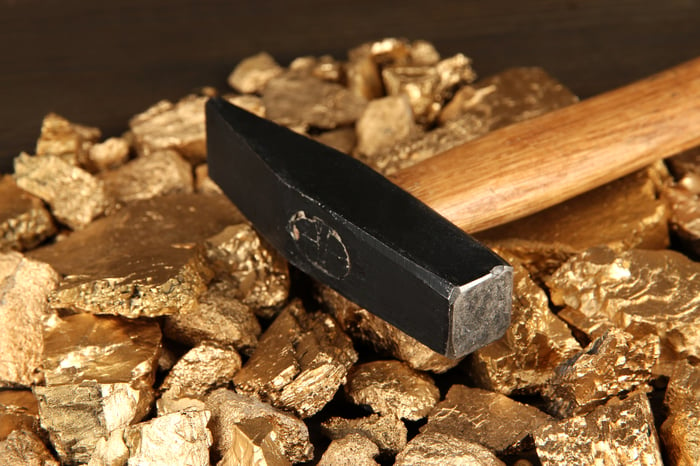Equivalent ounce is an investing term used throughout the mining industry. For example, miners that primarily focus on gold might use gold equivalent ounce (GEO), silver miners often use silver equivalent ounce, and copper miners would likely focus on copper equivalent ounces. All of these variations on the term equivalent ounce are meant to do the same thing, create an equal footing across a miner's portfolio so investors can more easily evaluate production.
Why does the term equivalent ounce exist?
In nature gold and most other metals are rarely found by themselves. So, for example, when a gold miner builds a mine it is often producing metals like silver and copper along with the gold. However, if the miner is specifically focused on finding gold, the byproduct metals can make it hard for investors to get a clear picture of the company's current production profile compared against historical production and when making comparisons to other miners.

Image source: Getty Images.
To simplify things, a gold miner with byproduct metals in its portfolio will often provide both gold ounces produced and gold equivalent ounces produced to show what the byproducts would add to production if they were hypothetically sold and used to buy gold. As noted above, this isn't unique to gold. Many metals are found together in nature. And depending on a miner's focus, some commodities may end up being tangential to the company's business. Using equivalent ounces makes it easier for investors to get a handle on production without the need to consider multiple metals.
How do I calculate an equivalent ounce?
Calculating gold equivalent ounces isn't terribly difficult. Roughly speaking, there are two equations you can use to turn byproduct production into a gold equivalent ounce:
(Byproduct Mined x Byproduct Price) / Gold Price = Gold Equivalent Ounces
Or
(Gold Price / Byproduct Price) x Byproduct Mined = Gold Equivalent Ounces
The resulting figure from either of these equations can then be added to the company's gold production to create an overall GEO figure for the company. Companies will usually provide the prices used in the above equations, since the current spot price for a given metal will most likely be different from the one used to create the financial report or news release at which you are looking. If not, then a conversion ratio will normally be provided, which is simply the gold price divided by the byproduct price in the second equation above.
Some miners even calculate multiple variations if their production is split roughly evenly between two metals or if they are attempting to shift their focus from one metal to another over time. So, for example, a miner with a 50/50 split between silver and gold production might provide both a silver equivalent ounces metric and gold equivalent ounces. The silver equivalent ounces metric will effectively assume that all of the company's gold production is sold and the proceeds are used to buy silver. The gold equivalent ounces production will do the opposite.
A quick hypothetical example
Let's do a little math to see how the equations work. Assume a miner produces 500 ounces of gold and 15,000 ounces of silver. The gold price for the period is $1,250 an ounce and the silver price is $15 an ounce. The math looks like this:
(15,000 * $15) / $1,250 = 180 GEOs
Now add the 180 GEOs to the 500 ounces of gold produced to get an overall production figure of 680 GEOs for the miner.
What's the benefit of GEOs?
Every miner has a slightly different production profile based on the mines they operate. By providing equivalent ounces, companies are attempting to make comparisons between different companies and different reporting periods easier. Essentially, by using GEOs you can compare like to like, and not have to complicate the picture with copper and silver that aren't a primary part of a gold miner's goals or production. The same is true for the other equivalent ounce variations.
Don't ignore the byproducts
Gold equivalent ounce, or the other variations, make it easier for investors to make comparisons. However, it's still important to remember that each commodity has its own supply and demand dynamics that drive prices.
For example, most gold demand stems from the jewelry and investment spaces, while silver and copper see significant demand from industrial sources. These variations can have a material impact on the prices of the metals over time. Copper tends to rise in price when economic growth is strong, as demand for products that use copper (like wires and pipes) increases. Gold, on the other hand, is seen as a store of wealth when times are tough. It tends to do relatively well when the markets are facing turbulent times, like during economic contractions that might push the price of copper lower.
Simply put, the current prices and price trends for the byproduct metals can have a material impact on how much they contribute to the overall GEOs figure. This doesn't negate the value of using GEOs, but it is something that investors should keep in mind as they look at a miner's financial reports.
Imperfect, but useful
In the end, gold equivalent ounces (or other equivalent ounce variations) allow investors to more easily compare a company's production to its own history and to the production of industry peers. The numbers will vary over time depending on commodity prices of the byproduct metals, but that's a relatively modest concern compared to the value provided by the GEO figures. Now that you have a better handle on this metric you'll have another tool at your disposal when evaluating the quarterly reports from the miners in your portfolio.




